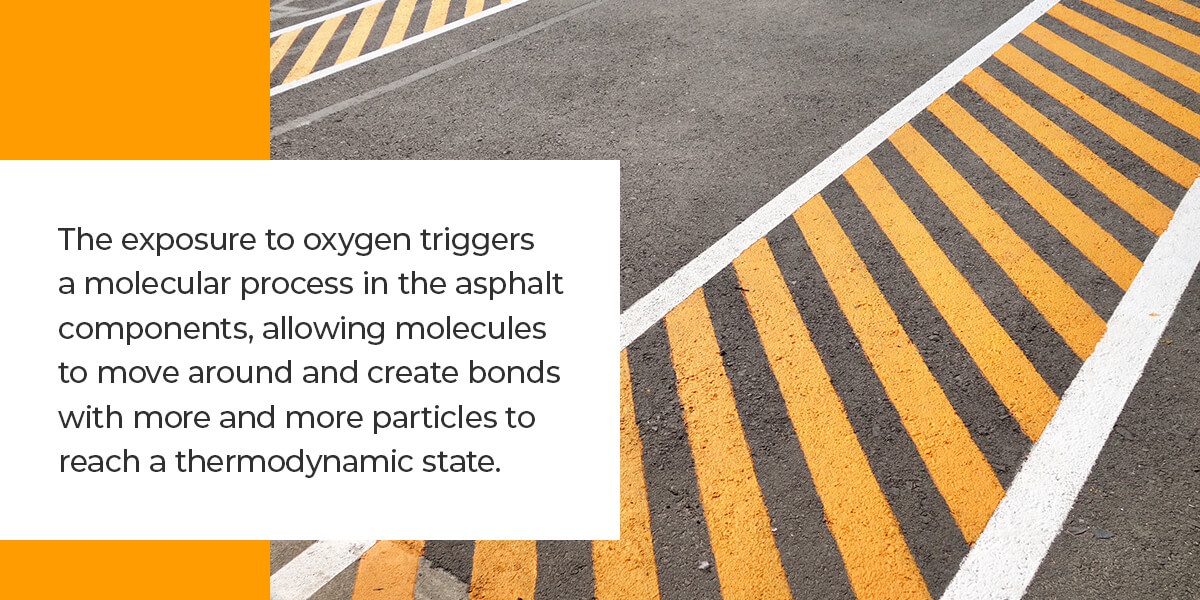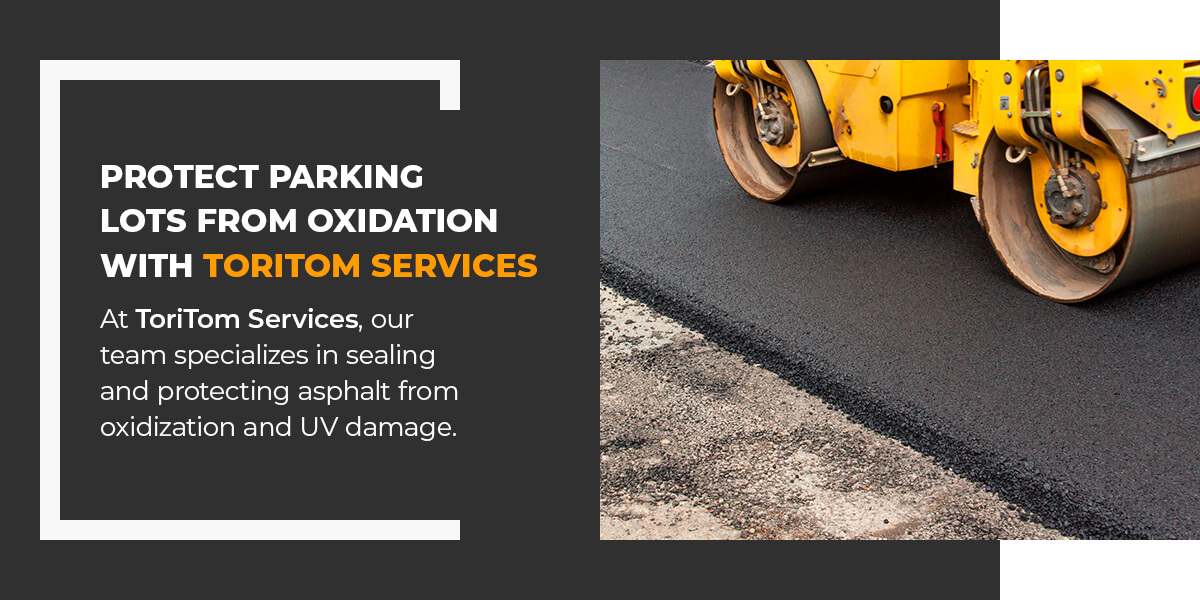
Oxidation can’t be stopped — it’s a natural process. It does, however, create the need for maintenance over time in asphalt parking lots. Managers of commercial properties have likely seen the damage due to asphalt oxidation, but what causes oxidation and how do you prevent it?
The asphalt oxidation process must be effectively managed in order for commercial properties to stay safe and visually appealing. Whether you’re a commercial property manager, a franchisee or renting a commercial site, you need to be aware of the impact of asphalt oxidation.

What Is Oxidation in Asphalt?
Oxidation refers to the process that happens when an element combines with oxygen. In other words, this process happens to anything that comes into contact with oxygen. As far as asphalt is concerned, oxidization is the primary factor in the aging of pavements and parking lots over time. By being in contact with oxygen, asphalt is continuously undergoing the aging process.
The exposure to oxygen triggers a molecular process in the asphalt components, allowing molecules to move around and create bonds with more and more particles to reach a thermodynamic state. Over time, the process becomes more pervasive and can lead to expensive repairs and even replacements if left untreated.
Several variables influence the rate of oxidation in asphalt, including temperature, time and maintenance routines. The moment the asphalt has been laid down, the process begins, making it necessary to watch for signs of severe oxidation. Once the symptoms have been identified, quick action is required to prevent further damage.
The Impact of Oxidation on Parking Lots
The longer that oxidation is allowed to continue, the greater the impact will be on a parking lot. As the lot is exposed to oxygen, the color fades from black to grey, taking on an ashen appearance. While this is occuring, the asphalt becomes more rigid and brittle.
As the asphalt oxidizes and becomes rigid, it gets more fragile and cracks appear. The cracks allow more oxygen, water and debris to penetrate deeper into the base, affecting the parking lot’s overall integrity and making it less pleasing to the eye. The oxidation process decreases the safety and effectiveness of the asphalt as well as its visual appeal. Oxidized asphalt can give the impression that a property isn’t being cared for as it should.
It’s important to understand the implications of the oxidization process because it shortens the life span of a parking lot. Once cracks have appeared in the asphalt’s surface, its load-bearing capacity is severely compromised. As the oxidation process takes hold, it’s more likely that the parking lot will sustain severe damage.
Property managers must monitor the process and act when necessary. If this area of property management is neglected, the results could be costly. With preventative measures in place for asphalt parking lots, managers can slow down the oxidation rate and ensure the asphalt’s longevity. Taking the initiative to mitigate the oxidation process is a long-term investment.
Signs of Asphalt Oxidation
The first step in minimizing the effects of asphalt oxidation is being able to identify signs that the process is occurring and requires intervention.
Symptoms of asphalt oxidation in a parking lot include:
- Debris: What looks like debris in a parking lot is actually the asphalt coming loose from the lot itself. Chunks of asphalt may be visible.
- Faded color: Asphalt is black when it’s freshly laid. Over time, the color fades. It’s possible the stone aggregate underneath may become visible as well.
- Cracks and potholes: As oxidization slowly breaks down the integrity of the asphalt, cracks will appear and pieces of asphalt will start to chip away, leading to potholes in the long term.
- Warping: As the asphalt weakens and water or other particles get inside the fissures, the shape of the ground may change. The result is warping in some areas and swelling in others.
- Weeds and other vegetation: When there is moisture and darkness, greenery will begin to grow. Vegetation growing out of cracks in asphalt is a clear sign that the seal has been compromised and water is eroding the foundation beneath the surface.
- Spreading: Tar takes on a liquid quality as it’s heated by the sun. As a result, it can move to the corners of the lot over time. When this happens, areas of the asphalt will appear thin.
- Stains: Oil and other chemicals leak onto the parking lot’s surface. Stains are unsightly, and they can seep into the asphalt and undermine the parking lot structure.
- Puddles: When water collects in one place, this signifies that the parking lot is no longer level due to oxidation. Asphalt that has become uneven in specific areas requires immediate attention.
How to Prevent Asphalt Oxidation
There is no way to halt the oxidation process altogether — however, there are several methods to prolong the integrity of an asphalt parking lot and reduce the oxidation rate. Regular care and maintenance is crucial to preserve asphalt for as long as possible.
Here are four steps that commercial property managers can take to prevent the progression of asphalt oxidation:
- Regular cleaning: Any parking lot will inevitably collect leaves, dirt and other particles. These may seem harmless but can degrade the asphalt and contribute to oxidation. Ensuring parking lots are swept and cleaned regularly is key.
- Even weight distribution: If possible, it’s important to distribute the weight of heavy vehicles evenly across the lot to prevent loading too much pressure in a single area.
- Patch repairs: If a weakness is identified, work with a professional to patch it in order to prevent further oxidation. Patching provides a less challenging method of handling ongoing maintenance requirements.
- Sealcoating: As soon as the asphalt is installed, a seal coat should be applied as the first line of defense against oxidation. After that, a seal coat should be applied every year or two depending on the oxidation rate.
Maintenance is highly effective in reducing oxidation rates. For any parking lot to achieve maximum longevity, it’s advised to consult a professional that specializes in commercial services and repairs.
Protect Parking Lots From Oxidation With ToriTom Services
As a commercial property manager, you want to know you’re getting the best possible service when it comes to something as integral as a parking lot. At ToriTom Services, our team specializes in sealing and protecting asphalt from oxidization and UV damage.
Our team will handle all your parking lot repair needs, from assessing the damage to finding the solution best suited to your requirements. We can also create and execute a maintenance plan for the parking lot on a commercial property you manage.
Contact us today to get started with our services, or call us at 941-932-2593.

